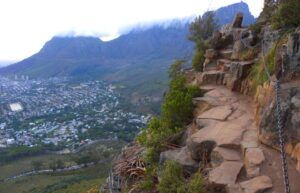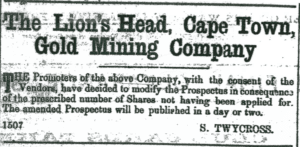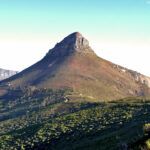Lion’s Head
Lion’s Head is part of Table Mountain National Park. The mountain is narrow and has ledges on which you can navigate, assisted by a guide. Lion’s Head is 669 meters above sea level and has the best views of Cape Town both toward the sea and also Table Mountain. The suburbs of the city surround the peak and Signal Hill on almost all sides, but strict management by city authorities has kept the development of housing off the higher ground. The area is significant to the Cape Malay community, who historically lived in the Bo-Kaap close to Lion’s Head. There are several historic graves and shrines (kramats) of Malay leaders on the lower slopes.
The English called the mountain Sugar Loaf in the 17th century. But the Dutch called it Leeuwen Kop (Lion head), Signal Hill was known as Leeuwen Staart (Lion’s Tail), This is because the shape resembles a crouching lion or a sphinx. Van Riebeek’s diary from1652 refers to the ships anchoring near the “tail of the lion mountain’
The mountain has been used as a lookout from the start of the European settlement. The Dutch established a permanent lookout. There was a flagpole on the summit. The signaller lived at Kloof nek which was then known as Vlaggeman’s hoogte. (Flagman’s heights) He would hoist the flag when incomming ships were spotted. A cannon was fired one or more times according to the number of vessels seen.
The signaller’s ladder has rusted away, but in 1881 two young men both blacksmiths named Welsh and Hellings, who had come to Cape Town to work at the docks, decided to affix chains to the rocks to assist climbers.
WATCHMAN’S CAVE
The cave on Lion’s head has special significance in Winter as at the winter solstice the eye of the watchman’s cave is lit up by the sun. From the cave, you can see the whole North Western part of the peninsula with Robben Island beyond. The cave would have been used by Shamans and Sangomas. Archaeoastronomical research shows that the Watchman’s Cave is of prime importance because of its location on the side of the head of the “Great Lion” that guards the Gateway between Table Mountain & the ocean.
Further down this hill, there is a Giant Head that has an eye socket facing west, capturing the afternoon sun during the summer. The light hits the floor of a small cave & then reflects up the wall beside it, creating a “Sundial” effect. These were important Sacred Sites for ancient peoples
Hikes on Lion’s Head
Dog-friendly short moderate hike (90 mins). The hike takes you through the Table Mountain range. It is open every day of the week for well-behaved dogs on a leash. Access is free however it’s best to hike early in the morning or late in the afternoon.
There are guided hikes on Lion’s Head which take about 45 minutes up at a fast pace or 90 minutes at a moderate pace. The round trip is about four hours. Lion’s Head trail is steep but doable, while the 5.5km trail is challenging. The views from the Lion’s head are spectacular. Hike participants can do the challenging Chain Route (for groups only). Otherwise, there is the Spiral Route which is the safer way to summit Lionhead

The Lion’s Head hike begins at the intersection of Table Mountain’s Tafelberg Road and Lion’s Head Signal Hill Road, Cape Town. Times are 4 am, 7 am, 10 am, 16 pm You will need to take with you some snacks and plenty to drink.
The entrance to Lion’s Head is on Signal Hill Road, at the Base of Forestry Road. Coming from the middle of town, head up towards the mountain in the direction of Camps Bay, via Kloofnek Road. You will spot the turn-off for Lion’s Head at the lowest point between Table Mountain on the left and Lion’s Head on the right.
The Lions Head hike is popular for after-work hikes and on nights when there’s a full moon. There’s a little bit of climbing involved, but the handholds and chains help you on your way up and down. You can also take the roundabout way, which skips the climbing part, making it suitable for hiking with children or dogs. Also called Klein Leewkoppie this short, but difficult trail to the summit should take you less than an hour.
The hike is on Klein Leeukoppie, which is on private property. Go up the path until you reach a bend near the radio mast. Take a path to the left (those off to the right above Llandudno might seem more defined, but they do not go anywhere). The path is not very good, but with a little effort, most hikers will manage the rocks.
Near the top, things get a little more difficult. In the last few hundred metres, there is a fair amount of rock scrambling.
Leeukoppie Rd, Hout Bay,
More information about hiking on Lions Head
The kramat that is situated on Lion’s Head is probably the easiest one to visit. it is placed on the “Lion’s rump” area viewpoint, it is just above the road. Visitors are asked to be respectful when visiting these sites, shoes must be removed when entering.
For the hikes contact bookings@lionsheadhike.com
WhatsApp 081 762 5551
Lion’s Head Gold mine
In the late 1600s, it was believed that there were quite likely gold deposits in the Cape. There are in fact some, but they are too small to be viable. Gold was in fact found in 1865 in Camps Bay on the property of Captain Glendinning. In 1865 gold was found on the slopes of Table Mountain. Then in 1886, there were claims of new finds in Noordhoek. Then in 1887 on a farm on the slopes of Lion’s Head, owned by Jan Hofmeyr, gold was found. This was the start of a mini gold rush. The Lion’s Head Gold Syndicate was formed. A 45-meter shaft was sunk on the Cape Town side of the nek. Later a tunnel was made from the Sea Point side. From a ton of quartz containing pyrite, two ounces of gold were obtained at Wilkinson’s Mill in Kloof Street., However, the gold was low-grade so the mine closed the following year.


7 ½ tons of ore were sent to Britain and Germany, but only 10 pounds were actually tested. the results showed no gold. This was a great blow to the Mining Company which would no longer attract investors. By 1893 the Company disbanded.
. The shaft remained open until 1951 when a firefighter who was battling a mountain fire almost fell in. As a result, the entrance was bulldozed over and permanently closed off. The shaft was filled in and a small depression is all that remains of the mine today.
Important numbers to have when visiting Table Mountain National Park venues
- Emergencies:021 480 7700
- Medical emergencies from a cellphone:112
- Table Mountain National Park: 021 957 4700/ 0861 106 417
- Wilderness Search and Rescue: 021 948 9900


